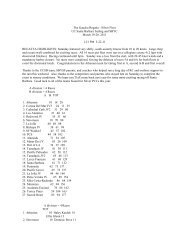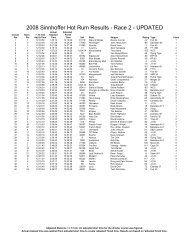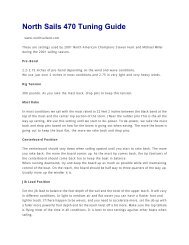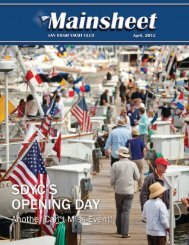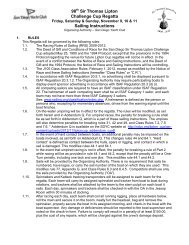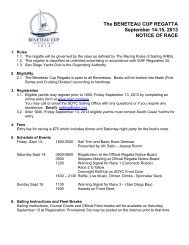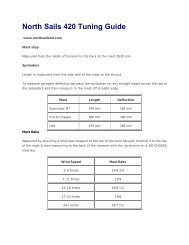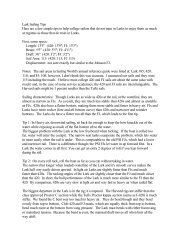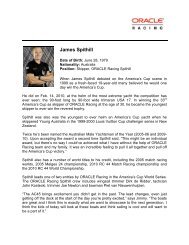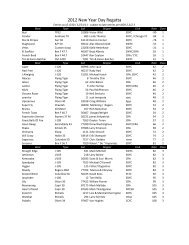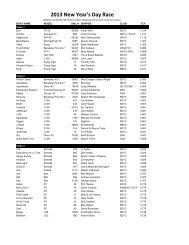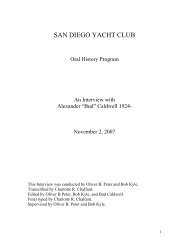PATON Discrepancy Review
PATON Discrepancy Review
PATON Discrepancy Review
Create successful ePaper yourself
Turn your PDF publications into a flip-book with our unique Google optimized e-Paper software.
Prevention<br />
(Marine Safety)<br />
Department<br />
Navigation<br />
System<br />
Division<br />
<strong>PATON</strong><br />
DISCREPANCY<br />
REVIEW<br />
1
Presentation<br />
Objectives<br />
• To acquire a general knowledge of the<br />
responsibilities of the Auxiliary for<br />
checking aids for discrepancies.<br />
• To understand the three classes of<br />
private aid to navigation.<br />
• To be able to recognize a discrepancy<br />
on a private aid to navigation.
<strong>PATON</strong><br />
Categories<br />
Class 1<br />
Class 2<br />
Class 3
Definition of Class I<br />
An aid to navigation on a<br />
marine structure or other<br />
works, which the owner is<br />
legally obligated to<br />
establish, maintain and<br />
operate.<br />
Aid still needs a Coast<br />
Guard permit.
Definition of Class 2<br />
An aid to navigation,<br />
exclusive of Class 1,<br />
which is located in<br />
waters used by<br />
general navigation.<br />
Usually are lateral aids.
Definition of Class 3<br />
Aids to Navigation,<br />
exclusive of Class 1,<br />
which are located in<br />
waters not ordinarily<br />
used by general<br />
navigation.<br />
Often are regulatory buoys.
A<br />
I<br />
D<br />
D<br />
E<br />
F<br />
E<br />
C<br />
T<br />
S
M<br />
O<br />
R<br />
E<br />
I<br />
S<br />
S<br />
U<br />
E<br />
S
LED LANTERN<br />
(Light Emitting Diode)
Model 601<br />
• Not approved for<br />
use by USCG.<br />
• 2 NM range.<br />
• Self-contained.<br />
• May be used on<br />
private aids.<br />
• Small, lightweight,<br />
easy to install,<br />
inexpensive.<br />
11
Programming the light<br />
characteristic:<br />
• Lantern color determined by colored dot near<br />
serial number.<br />
• Any flash characteristic can be programmed<br />
using a Universal TV remote control.<br />
• Security code must be entered to prevent<br />
accidentally changing characteristic.<br />
• Follow instructions supplied with lantern.<br />
12
Service Life of Lantern<br />
• LED lanterns do not burn out.<br />
• Light output degrades over time.<br />
• Replace lanterns according to Duty<br />
Cycle.<br />
• 10-29% duty cycle replace every 12 yrs.<br />
• 30-100% replace every 8 years.<br />
• Replace battery every 4 years.<br />
13
Battery Box<br />
• There are single<br />
and double battery<br />
boxes.<br />
• A vent valve must<br />
be installed.<br />
• Box may be<br />
painted the color of<br />
the buoy.
Sound Systems<br />
There are three main types of wave<br />
actuated sound signals:<br />
Whistle<br />
Bell<br />
Gong
Whistle<br />
• Whistle is made<br />
of cast bronze<br />
and is mounted<br />
inside the cage.<br />
• As air is forced<br />
through the<br />
whistle, the<br />
familiar drone<br />
sound is made.
BELLS<br />
• Bells used on<br />
lighted and<br />
unlighted buoys<br />
and are made of a<br />
copper-silicon<br />
alloy.<br />
• External tappers<br />
impact the fixed<br />
bell when wave<br />
motion causes the<br />
buoy to roll.
Small Lights<br />
and Daymarks
Don’t<br />
get<br />
too<br />
close<br />
to this<br />
ATON!<br />
Stay<br />
in the<br />
channel.
Check after<br />
storms.<br />
Panels are<br />
designed to<br />
break away so<br />
that high<br />
winds or<br />
waves will not<br />
destroy the<br />
supporting<br />
pile or<br />
structure.
Single Pile Structure<br />
• Used in protected or<br />
semi-exposed<br />
locations where<br />
fixity can be<br />
attained.<br />
2
Multiple Pile Structures<br />
• Used when fixity can not be<br />
achieved with single pile.<br />
• Two categories:<br />
Dolphin<br />
Platform Structure
Dolphin<br />
13<br />
•Battered pile<br />
Three to seven<br />
piles driven at an<br />
angle with the<br />
bottoms spread<br />
and the tops<br />
secured with wire<br />
rope or bolts and<br />
shear connectors.
Dolphin<br />
•Cluster pile<br />
• Three or more piles<br />
driven vertically with<br />
their surfaces in<br />
contact with each<br />
other and wrapped<br />
tightly at various<br />
heights.<br />
1
#7, a small light, off Castle Island<br />
in Boston Harbor.<br />
25
Lantern<br />
Platform<br />
Structure<br />
Battery Box<br />
•<br />
Things Three or to more separate<br />
Tower<br />
piles driven vertically,<br />
check on<br />
connected at the top by a<br />
this aid.<br />
platform that spreads the<br />
load over all the piles.<br />
Usually is the Platform foundation<br />
for skeleton Structure towers.
Dayboards<br />
•A dayboard shall always be<br />
installed for maximum utility.<br />
•The dayboard should be the<br />
dominant component of the<br />
silhouette with the battery<br />
box hidden behind it.
On what side<br />
should you pass<br />
this mark?
It is a little<br />
easier to<br />
make the<br />
decision in<br />
the daylight!
Raising the<br />
dayboard<br />
makes it more<br />
obvious.
Dayboards<br />
• The first letter refers to the shape or purpose<br />
of the dayboard.<br />
S-Square T-Triangle J-Junction<br />
M-Mid-Channel K-Range N-No Lateral Significance
Dayboards<br />
• The letter represents the key or<br />
background color.<br />
R- Red<br />
G- Green<br />
W- White<br />
B- Black
Dayboards<br />
Additional information is shown by letters<br />
placed after a dash (-)<br />
I - Intracoastal<br />
SY - yellow square<br />
TY - yellow triangle
Front<br />
Panel<br />
Symbol<br />
KWR<br />
Main panel is<br />
white.<br />
Center stripe<br />
is red.
Dayboards<br />
• The letter indicates the color of stripe<br />
• (range dayboards only).<br />
R- Fluorescent red G- Fluorescent green W- White B- Black
Operational Requirements<br />
•Contrast<br />
Vegetation<br />
Background<br />
lights
Backing Material<br />
• Delamination should not have<br />
progressed over more than 25 percent of<br />
the backing material.<br />
• Material should not be sufficiently warped<br />
to visibly detract from the signal.<br />
• Mounting points should not be softened or<br />
deteriorated to the degree that the board<br />
may come loose during a storm.<br />
• Great photo opportunities.
Films, Numbers, Letters, and<br />
Borders.<br />
• Delamination of the film should not<br />
progress over 10% of the surface area.<br />
• Material should not be cracked, checked<br />
or abraded so as to provide a dull or<br />
roughened top surface.<br />
• Attached material should not have peeled<br />
more than 10% of the surface area.<br />
• Good Photo opportunities
Fading. . .<br />
• There is no practical way to measure<br />
fading.<br />
• Replacement is based on the judgment<br />
of servicing personnel.<br />
• Aid must be able to display the<br />
intended signal until its next<br />
scheduled service date.
. . . more FADING<br />
1 3 5<br />
NEW FADED REPLACE
HOW to report non-permitted<br />
aids to the CG ANT<br />
(Coast Guard Aid to Navigation Team)<br />
“NS-PN03 Private Aid to Navigation Report”<br />
Important to identify the name of the aid’s owner.<br />
The owner is responsible for submitting an<br />
application and for making all repairs and updates<br />
for a <strong>PATON</strong>-Private Aid to Navigation.
NS-PN03 <strong>PATON</strong> <strong>Discrepancy</strong> Report<br />
Has nine sections:<br />
1. Member information.<br />
2. Coast Guard Notification.<br />
3. Aid Identification.<br />
4. Horizontal and Vertical Locations.<br />
5. Aid to Navigation Characteristics.<br />
6. Discrepancies Observed on Aids to Navigation.<br />
7. Non-Permitted Aids to Navigation Data.<br />
10. Comments.<br />
11. Report Distribution.
A COPY OF THE<br />
NS-04 PRIVATE AID TO NAVIGATION<br />
REPORT<br />
IS BEING HANDED OUT FOR THIS PART<br />
OF THE PRESENTATION.<br />
PLEASE FOLLOW ALONG WHILE<br />
REFERENCING THIS FORM.
NS-PN04 – Private Aid to Navigation Report<br />
Section 1. MEMBER INFORMATION<br />
Fill out your personal data:<br />
SECTION 1 - MEMBER INFORMATION<br />
MEMBER NUMBER LAST NAME, FIRST NAME AND INITIAL TELEPHONE NUMBER UNIT (DIST/DIV/FLOT)<br />
1134567 JONES, JAMES A.<br />
DATE OBSERVED TIME OBSERVED OPCON E-MAIL ADDRESS<br />
14-Mar-2009 2200 ANT BOSTON<br />
789-344-6789 013-10-07<br />
JAJONES@AOL.COM<br />
MEMBER NUMBER<br />
LAST NAME, FIRST NAME, INITIAL<br />
TELEPHONE NUMBER – Where you can be reached during<br />
normal business hours.<br />
UNIT (Dist/Div/Flot) i.e. 013-10-07 = D1, Division 10, Flotilla 7.<br />
DATE OBSERVED<br />
TIME OBSERVED<br />
OPCON<br />
E-MAIL ADDRESS
NS-PN04 – Private Aid to Navigation Report<br />
Section 2 – COAST GUARD NOTIFICATION<br />
Only use when you have already communicated directly<br />
with a C.G ANT or other C.G. agency.<br />
COAST GUARD UNIT NOTIFIED<br />
ANT BOSTON<br />
<br />
<br />
<br />
<br />
TIME REPORTED<br />
2240<br />
DATE REPORTED<br />
4-May-09<br />
COMMUNICATION METHOD USED FOR REPO<br />
TELEPHONE<br />
Coast Guard Unit Notified.<br />
Time Reported (hhmm)<br />
Date Reported (DD-MMM-YY)<br />
Communication method used: (Information block)<br />
Radio, Telephone, E-Mail, Other, see Comments.<br />
This section is NORMALLY not used when<br />
reporting non-permitted aids to navigation.
NS-PN04 – Private Aid to Navigation Report<br />
Section 3 AID IDENTIFICATION<br />
Aid ownership - Select the type of owner:<br />
COAST GUARD<br />
STATE<br />
PRIVATE - <strong>PATON</strong><br />
USACE – US Army Corps of Engineers<br />
NOAA<br />
AID OWNERSHIP - check one: X COAST GUARD STATE PRIVATE USACE<br />
LLNR<br />
OFFICIAL NAME OF AID BEING REPORTED<br />
DORCHESTER BAY LIGHTED BUOY 5<br />
CHART NO.<br />
13270<br />
ED CHART DATE<br />
34 Sep-07<br />
(Reference the Light List fo<br />
LLNR [Will not be known or not have one]<br />
NAME OF THE AID [Use the Light List as a guide]<br />
<strong>PATON</strong> NUMBER [May not be known]<br />
CHART NUMBER<br />
CHART EDITION<br />
CHART DATE (MMM-YY)<br />
<strong>PATON</strong> NUMBER
NS-PN04 – Private Aid to Navigation Report<br />
Report Section 4 – HORIZONTAL AND VERTICAL LOCATIONS.<br />
LATITUDE [DD-MM-SS.SS N]<br />
23-34-56.80 N<br />
LONGITUDE [DDD-MM-SS.SS W]<br />
071-03-45.80 W<br />
GPS DATUM<br />
WGS84<br />
METHOD USED TO TAKE FIX<br />
GPS WITH WAAS<br />
LATITUDE – (Formatted as DD-MM-SS.SS N)<br />
LONGITUDE – (Formatted as DDD-MM-SS.SS W)<br />
GPS DATUM – (DATUM loaded in your GPS Set)<br />
METHOD USED TO TAKE FIX – Select:<br />
GPS, DGPS, GPS with WAAS, or OTHER, see Comments.<br />
QC READING U/M TIME WHEN TAKEN<br />
EPE 12.3 FT 1245<br />
QC CHECK<br />
QC CHECK, select:<br />
HDOP (Horizontal Dilution of Position)<br />
EPE (Estimated Position Error)<br />
QC READING (EPE or HDOP reading on site from GPS.)<br />
TIME WHEN TAKEN – Format as HHMM. as HHMM)
NS-PN03 – Private Aid to Navigation Report<br />
Section 4 – HORIZONTAL AND VERTICAL LOCATIONS.<br />
OFFICIAL NAME OF LOCATION<br />
PULPIT HARBOR, CAMDEM MAINE<br />
GPS MANUFACTURER AND MODEL NUMBER<br />
GPS 72 - GARMIN<br />
OFFICIAL NAME OF LOCATION – where the aid is located.<br />
GPS MANUFACTURER AND MODEL NUMBER.<br />
GPS OPERATION<br />
3D<br />
GPS OPERATION, select:<br />
2D<br />
3D<br />
3D DIFFERENTIAL<br />
NOT AVAILABLE
NS-PN03 – Private Aid to Navigation Report<br />
Section 4 – HORIZONTAL AND VERTICAL LOCATIONS<br />
CHT. DEPTH U/M DEPTH DIFFERENCE<br />
12.0 FT 0.6 FT<br />
METHOD USED FOR DEPTH MANUFACTURER AND MODEL NUMBER<br />
• CHARTED DEPTH – take from the NOAA chart.<br />
• DEPTH DIFFERENCE – system calculated.<br />
• METHOD USED FOR DEPTH - ECHO SOUNDER, LEAD LINE, SOUNDING POLE, DEPTH<br />
NOT TAKEN, OTHER, see Comments.<br />
• MANUFACTURER AND MODEL NUMBER of echo sounder.<br />
• OBSERVED DEPTH – take from the echo sounder.<br />
OBSERVED<br />
DEPTH<br />
CORR. FOR<br />
TRANSDUCER<br />
ECHO SOUNDER WIDE 100 HUMMINGBIRD 11.4 FT 2.0 FT<br />
• TRNSDCR CORR. – Distance from the location of the transducer to the waterline.
NS-PN03 – Private Aid to Navigation Report<br />
Section 4 – HORIZONTAL AND VERTICAL .<br />
HEIGHT OF TIDE CORR. DEPTH TIME OF OBSERVATION<br />
4.1 FT 9.3 FT 1350<br />
HEIGHT OF TIDE – take from the Almanac Screen on your GPS.<br />
CORRECTED DEPTH AT DATUM – system calculated.<br />
TIME – when the depth was taken, format as HHMM.
NS-PN03 – Private Aid to Navigation Report<br />
Section 5 – AID TO NAVIGATION<br />
CHARACTERISTICS.<br />
Check boxes that apply:<br />
‣ TYPE OF AID<br />
‣ TYPE OF BUOY<br />
‣ AID STRUCTURE<br />
‣ LIGHT COLOR<br />
‣ SOUND<br />
‣ ELECTRONIC
NS-PN03 – Private Aid to Navigation Report<br />
Section 6 – DISCREPANCIES OBSERVED.<br />
Check any discrepancies that are observed on<br />
the private aid:<br />
• CRITICAL DISCREPANCIES<br />
• URGENT DISCREPANCIES<br />
• ROUTINE DISCREPANCIES<br />
• DOCUMENT AND SPECIFICATION CHECKS.
NS-PN03 – Private Aid to Navigation Report<br />
Section 7 NON-PERMITTED AID TO<br />
NAVIGATION DATA.<br />
Fill in as much information as you can. Priority is<br />
from the top downward.<br />
• Owners Name<br />
• Owners Telephone Number<br />
• Owners E-mail address<br />
• Owners Address, City, State, Zip<br />
• POC – Person of Contact.<br />
• Local Waterway Administrator – Harbormaster<br />
• Telephone Number<br />
• E-mail Address
What is meant by the term<br />
“checking” of a Private aid?<br />
<br />
<br />
<br />
<br />
You completed a full pre-underway check of your<br />
measuring devices per the guidelines and<br />
determined that they are working accurately and that<br />
all of the necessary tools are available.<br />
On-scene, you took a fix alongside the aid in the<br />
channel per the guidelines and recorded the data on<br />
a worksheet, including the Quality evidence.<br />
On-scene, you checked the depth of water per the<br />
guidelines and recorded the data on a worksheet,<br />
including the Quality evidence.<br />
You completed an 7054 <strong>PATON</strong> <strong>Discrepancy</strong> Report<br />
to notify the Coast Guard of any discrepancy.
REPORT all non-permitted private<br />
aids to the Coast Guard through<br />
established Division channels.<br />
ALSO REPORT all Private Aids to<br />
Navigation activity to AUXDATA as<br />
a Mission 31 on an 7030 Activity<br />
Report – Mission Individual form.<br />
A non-permitted private aid report is<br />
considered a discrepancy/
Any more<br />
questions about<br />
reporting Nonpermitted<br />
Private<br />
Aids to Navigation?



